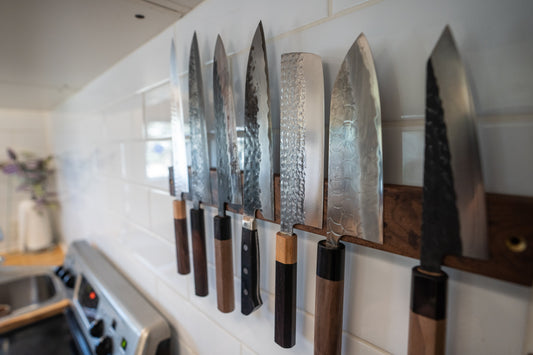How to Use a Santoku - Knife Skills 101
Slice it! Chop it! Dice it! I promise this isn’t a blog about a late-night infomercial product that barely works, but it IS about the Japanese kitchen knife known as the Santoku. The name translates to “three virtues,” which refers to its ability to slice, dice and chop, and how it’s an amazing and practical knife to use on your meat, fish, or vegetables. This knife can literally do it all, hence its name. When we get people coming into the shop just looking for one knife to start with, this is the one I’m suggesting. Here’s why!
How to Use a Santoku Like a Chef
First off, it’s long enough to tackle nearly every job in the kitchen, yet not so large that it feels overwhelming or intimidating. Secondly, the height on the blade makes it perfect for chopping into larger vegetables and not having to worry about punching your knuckles into your cutting board, especially if you’re using what us knife nerds refer to as the "pinch grip" while you cut.

Holding your knife this way gives you much more stability and control while you cut. There's a reason you see chefs using it everywhere, from your local pub to the Food Network. Use your forefinger and thumb to gently pinch the blade, and the rest of your fingers hold the handle, and now you’re ready to rock!
Although the cutting edge on the santoku is relatively flat, the curve as it gets closer to the tip, lends itself perfectly to making a gentle forward sliding or drawing-back motion, letting you make paper-thin slices of whatever you're cutting. You’re now a human mandolin!
Now here is where the flat part of the blade comes into play. Because you get so much contact with the cutting board, you’re going to get a clean cut through whatever you’re chopping or dicing and not have to worry about having that "accordion effect", where all the pieces are still connected by a tiny membrane from not cutting all the way through your food. You can now take those slices you’ve made, chop them down into tiny matchsticks, and then take those matchsticks and dice them up even more finely.
This sliding technique not only allows for nice, clean cuts, but it's also easier on the edge of your knife, so your favourite kitchen companion will keeps its edge longer! Once you get the hang of sliding, you can even start to incorporate a little rock into the cut. This allows you to get the most out of the knife's shape, without aggressive rock-chopping you see on TV, which can dull your edge quickly.
If you do like to rock your knife when mincing herbs, just do so gently! You can gently rock it through a pile of parsley with your hand resting gently on the top of the blade. Just be sure not to press your knife into the board aggressively. Why? You got it, aggressive chopping is hard on your edge. You can get more in-depth about good v.s. not-so-good knife technique here.
There you have it: the Goldilocks of Japanese kitchen knives. It’s not too big, not too small; it’s just right. When you get your new knife, buy some unusual vegetables and take some time to experiment with different techniques, so you can figure out how to make the most out of your santoku. The only tricky part now is finding the right one (or two, or three...) if you don't own a santoku already. Check out the links below if you need help picking a santoku, or just wanna get shopping!





